· Todd Martin · Home Cleaning · 15 min read
How To Clean Caulking Around Tub

Restore Sparkle: How to Clean Caulking Around Your Tub
Is your bathtub caulk looking a little worse for wear? Over time, caulk around your tub can gather unsightly mold, mildew, and grime. This not only looks bad but also signals a need for proper cleaning. Knowing how to clean caulking around a tub is important for hygiene and maintaining your bathroom’s appeal.
I understand the frustration of seeing dark spots against a clean white tub. This guide offers practical steps and effective solutions to help you make your caulk sparkle again. We will cover everything from identifying the problem to preventing future discoloration. By the end, you will have a clear plan to refresh your bathroom space.
Takeaway:
- Address mold and mildew promptly to stop spread.
- Gather proper tools and cleaning agents before starting.
- Always test cleaning solutions on a small, hidden area first.
- Ensure good ventilation when cleaning with strong products.
- Regular cleaning prevents buildup and extends caulk life.
To clean caulking around a tub, first identify the type of stain. Then, use appropriate cleaners like bleach, vinegar, or hydrogen peroxide with scrubbing tools. Apply the cleaner, allow dwell time, scrub gently, and rinse thoroughly to remove mold, mildew, and grime.
Understanding Common Caulk Issues: Mold, Mildew, and Stains
Caulk forms a watertight seal around your bathtub, but it often becomes a target for common bathroom problems. Mold, mildew, and various stains frequently appear on caulk. Understanding what causes these issues helps you choose the right cleaning method.
Mold appears as black or green spots. It is a fungus that grows in damp, warm environments. Mildew is a type of mold that looks powdery and often starts as white, grey, or yellow, then turns black. Both thrive in the constant moisture of a bathroom, especially around the tub. These growths are not just unsightly; they can also produce allergens. You should address them quickly.
Stains on caulk come from different sources. Soap scum, hard water deposits, and even dirt can discolor the caulk line. Hard water leaves mineral deposits that appear as white or reddish streaks. Soap scum builds up from body oils and soap residue, forming a greasy film. These stains might be less harmful than mold, but they still make your bathroom look dirty.
The type of caulk also plays a role in how it stains and how easy it is to clean. Silicone caulk resists mold better than acrylic caulk. However, silicone can still collect soap scum and hard water deposits. Acrylic caulk is more porous and tends to absorb stains and grow mold more easily. Knowing your caulk type can inform your cleaning strategy. This helps you select the most effective and safest cleaning products.
Essential Tools and Supplies for Cleaning Bathtub Caulk
Before you begin cleaning your bathtub caulk, gather all necessary tools and supplies. Having everything ready makes the process smoother and more efficient. Using the right items ensures a thorough and safe cleaning experience.
First, you need cleaning solutions. Bleach is a powerful disinfectant and mold killer. White vinegar offers a natural, milder option for mold and stains. Hydrogen peroxide is another effective, non-toxic choice. Baking soda creates a gentle abrasive paste. You might also want a specialized commercial caulk cleaner for tough jobs. Always check product labels for safe use on your specific caulk.
Next, gather your scrubbing tools. An old toothbrush works well for small, tight spaces. A small scrub brush or a grout brush can handle larger areas. Cotton balls or paper towels are useful for applying solutions and letting them sit. Microfiber cloths are good for wiping and drying surfaces. Avoid abrasive pads that could scratch your tub or damage the caulk surface.
Safety gear is also important. Always wear rubber gloves to protect your hands from harsh chemicals. Safety glasses protect your eyes from splashes. Ensure the bathroom has good ventilation; open windows or use an exhaust fan. This helps clear fumes, especially when using strong cleaners like bleach. Proper preparation helps you clean safely and effectively. You can also learn how to clean your toilet with these items.
Step-by-Step Guide: Cleaning Mildew and Mold from Tub Caulk
Cleaning mildew and mold from your tub caulk requires a systematic approach. Follow these steps to ensure a thorough cleaning. This process will help you restore your caulk’s original look.
Preparation is Key
First, clear the tub and surrounding area. Remove all bath products, toys, and anything else from the edges of the tub. Ensure the area is dry. Open a window or turn on the exhaust fan for ventilation. Put on your rubber gloves and safety glasses.
Apply Your Chosen Cleaner
For stubborn mold, I often reach for a bleach solution. Mix one part bleach with one part water in a spray bottle. Spray the solution directly onto the moldy caulk. For a more direct application, soak cotton balls in undiluted bleach. Then, place these cotton balls directly on the moldy areas of the caulk. This method ensures the bleach stays in contact with the mold for a longer time. If you prefer a less harsh option, hydrogen peroxide or a strong vinegar solution can also work. Apply these in the same manner. This is similar to how to clean caulking in shower.
Let it Sit
Allow the cleaner to sit on the caulk for at least 15-30 minutes. For very severe mold, you might need to let the bleach-soaked cotton balls sit for several hours or even overnight. The dwell time allows the cleaning agent to penetrate and break down the mold and mildew. Do not let the caulk dry out if using cotton balls. Reapply or remoisten as needed.
Scrub and Rinse
After the waiting period, remove the cotton balls or wipe the sprayed area. Use an old toothbrush or a small scrub brush to gently scrub the caulk. You will see the mold and mildew lift away. If some spots remain, reapply the cleaner and scrub again. Once clean, rinse the entire area thoroughly with warm water. Wipe it dry with a clean cloth. This prevents new mold growth.
Tackling Stubborn Stains on Bathtub Caulk
Sometimes, mold and mildew are not the only issues. Stubborn stains from soap scum, hard water, or other sources can also mar your caulk. These stains need different approaches than mold. Here is how I usually tackle them.
Dealing with Soap Scum and Grime
Soap scum leaves a cloudy or greasy film on caulk. A simple solution of dish soap and warm water often works for light buildup. Mix a few drops of dish soap with water in a spray bottle. Spray it onto the caulk, let it sit for a few minutes, then scrub with a brush. Rinse thoroughly. For tougher soap scum, I use a paste of baking soda and a small amount of water. Apply the paste to the stained caulk. Let it sit for 10-15 minutes. Then, scrub with a brush and rinse well. This abrasive but gentle method helps lift the grime without damaging the caulk.
Removing Hard Water Stains
Hard water stains appear as white, chalky, or even reddish deposits. These are mineral buildups. Vinegar is very effective against hard water stains because it is acidic. Soak paper towels in undiluted white vinegar. Press them onto the hard water stains on the caulk. Allow them to sit for 30 minutes to an hour. The acid will dissolve the mineral deposits. After the dwell time, remove the paper towels and scrub the area with a brush. You should see the stains disappear. Rinse the area thoroughly with water. If you are also dealing with other types of stains on your tub, these methods are similar to how to clean tub stains.
For Very Persistent Stains
Sometimes, stains just will not budge with standard methods. In these cases, you might need a commercial caulk stain remover. Always read the product instructions carefully. Test the product on an inconspicuous area first to ensure it does not damage your caulk or tub. Apply the product as directed, usually with a cloth or sponge. Allow it to work, then scrub and rinse. Remember to use proper ventilation and wear protective gear with stronger cleaners. If the caulk is too far gone, replacement might be the best option.
Natural and Eco-Friendly Caulk Cleaning Solutions
For those who prefer to avoid harsh chemicals, several natural and eco-friendly options effectively clean caulk around your tub. These solutions are safer for your family, pets, and the environment. I find them quite effective for regular maintenance and lighter stains.
White Vinegar Power
White vinegar is a cleaning powerhouse. Its acetic acid helps dissolve mineral deposits, soap scum, and even mild mold and mildew. For general cleaning, mix equal parts white vinegar and water in a spray bottle. Spray the mixture onto the caulk and let it sit for about 10-15 minutes. Then, scrub with an old toothbrush or soft brush. Rinse with water. For tougher mold, you can use undiluted vinegar. Soak cotton balls in pure white vinegar and press them onto the moldy caulk. Leave them overnight, then scrub and rinse. The strong smell of vinegar dissipates quickly.
Baking Soda Paste
Baking soda is a gentle abrasive and odor neutralizer. It works well on soap scum and light stains. Create a paste by mixing baking soda with a small amount of water. The consistency should be thick, like toothpaste. Apply this paste directly onto the stained caulk. Let it sit for 15-20 minutes. Then, scrub the paste into the caulk using a brush. The mild abrasive action helps lift grime. Rinse the area thoroughly with warm water. You can combine baking soda with vinegar for a fizzing action that helps loosen tough grime. Apply the baking soda paste first, then spray with vinegar. Let it fizz, then scrub.
Hydrogen Peroxide Solution
Hydrogen peroxide is a mild antiseptic and bleaching agent. It effectively kills mold and lightens stains without the harshness of bleach. Use 3% hydrogen peroxide, which is commonly found in drugstores. Spray or pour hydrogen peroxide directly onto the caulk. Allow it to sit for at least 10 minutes. For persistent mold, you can let it sit for a few hours. Then, scrub the area with a brush and rinse well with water. Hydrogen peroxide breaks down into water and oxygen, leaving no harmful residues. This makes it a great choice for eco-conscious cleaning. When using any of these methods, consider them as part of a routine to keep your bathroom clean and fresh.
When to Consider Recaulking Your Tub Instead of Cleaning
Sometimes, cleaning is not enough. There comes a point when caulk is too far gone, and recaulking your tub becomes the necessary step. Knowing when to recaulk saves you time and effort from ineffective cleaning. It also protects your bathroom from potential water damage.
One clear sign is extensive mold or mildew that does not respond to cleaning. If you have tried various cleaning methods, including bleach, and the dark spots persist, the mold has likely penetrated deep into the caulk. This happens with older, porous caulk or if the growth has been ignored for too long. Cleaning the surface will not remove the embedded mold. In such cases, the caulk must be removed and replaced.
Another indicator is cracked, peeling, or deteriorating caulk. Caulk provides a waterproof barrier. If it is cracking, shrinking, or pulling away from the tub or wall, water can seep underneath. This leads to hidden mold growth behind walls or under the tub. Water damage can be expensive to repair. Peeling caulk also looks unsightly and cannot be fixed by cleaning. It loses its functional purpose.
You should also recaulk if the caulk shows signs of crumbling or significant discoloration that is not just surface dirt. Over time, caulk can lose its elasticity and integrity. It becomes brittle and may chip away. If the caulk color has changed permanently to a dingy yellow or grey, it suggests deep-seated issues or material breakdown. Attempting to clean severely damaged caulk is futile. Replacing it offers a fresh, clean, and protective seal. This is a vital part of maintaining a clean bathroom and preventing costly repairs.
Preventing Future Caulk Discoloration and Growth
After putting in the effort to clean your tub caulk, you want to keep it looking fresh for as long as possible. Preventing future discoloration and growth is easier than constant deep cleaning. I always recommend proactive steps to maintain clean caulk.
Regular Cleaning Routine
The most important prevention step is regular cleaning. Make cleaning your caulk a part of your routine bathroom maintenance. After each shower or bath, quickly wipe down the caulk line with a towel. This removes excess moisture and prevents water from sitting on the surface. Once a week, I give the caulk a quick scrub with a mild bathroom cleaner or a vinegar solution. This prevents soap scum and light mold from building up. Consistent, small efforts make a big difference over time.
Ensure Proper Ventilation
Mold and mildew thrive in damp, humid environments. Good ventilation is crucial to reduce moisture in your bathroom. Always use your exhaust fan during and after showers. Run the fan for at least 15-20 minutes after you finish bathing. If you do not have an exhaust fan, open a window after each shower to let fresh air circulate. Leaving the bathroom door open can also help disperse humidity. Reducing moisture in the air directly inhibits mold and mildew growth on caulk and other surfaces.
Address Leaks Promptly
Even small leaks can provide constant moisture for mold to grow. Check your showerhead, faucet, and tub fixtures regularly for drips. If you notice any leaks, repair them immediately. A slow drip can cause significant mold growth on caulk and walls over time. Ensuring everything is watertight helps keep your caulk dry and clean. This also prevents water damage to your home structure.
Consider Mold-Resistant Caulk
When it is time to recaulk, choose a high-quality, mold-resistant silicone caulk. Many modern caulk products contain antimicrobial additives that resist mold and mildew growth. While no caulk is entirely immune to mold, these types offer significantly better protection. They cost a little more but save you cleaning effort in the long run. Proper caulk application also creates a smoother, less porous surface, making it harder for grime to stick.
FAQ Section
What causes black mold on caulk around a tub?
Black mold on caulk is usually caused by persistent moisture and lack of ventilation. Spores settle on damp surfaces and grow in warm, humid conditions. Soap scum and body oils provide a food source. This creates a perfect environment for mold to thrive, especially in bathroom areas like the tub caulk line.
Is bleach the only way to clean mold from caulk?
No, bleach is not the only way to clean mold from caulk. White vinegar, hydrogen peroxide, and baking soda pastes are effective natural alternatives. Commercial mold removers also work well. Bleach is strong, but vinegar or hydrogen peroxide can be safer for regular use and good for the environment.
How often should I clean the caulk around my tub?
You should wipe down the caulk after every use to remove excess moisture. A quick clean with a mild solution should happen weekly. Deep cleaning, targeting mold or stubborn stains, can be done monthly or as needed. Regular maintenance prevents heavy buildup and keeps the caulk looking fresh.
Can I paint over moldy caulk instead of cleaning it?
Painting over moldy caulk is not recommended. Paint will not kill the mold, and the mold will eventually grow through the new paint layer. You must clean or remove all mold before painting or recaulking. Painting over it only hides the problem temporarily and allows mold to spread.
When is it better to replace caulk than to clean it?
Replace caulk when it is heavily cracked, peeling, crumbling, or has deep-seated mold that does not respond to cleaning. If the caulk is no longer providing a watertight seal, it needs replacement. Cleaning only addresses surface issues; structural damage or persistent mold requires new caulk.
Are natural cleaners effective for all types of caulk stains?
Natural cleaners like vinegar and baking soda are effective for many common caulk stains, including soap scum, light mold, and hard water deposits. However, for extremely tough, deeply set stains or severe mold infestations, commercial caulk cleaners or bleach might be necessary. Effectiveness depends on stain severity.
Conclusion
Cleaning the caulk around your tub is a crucial task for maintaining a fresh and hygienic bathroom. We have explored effective methods, from using common household items like bleach and vinegar to tackling stubborn stains with targeted approaches. Remember, the key to success lies in understanding the problem and choosing the right tools. I have found that a consistent cleaning routine is the best defense against mold, mildew, and grime buildup.
By following the steps outlined, you can transform dingy, stained caulk into a sparkling, clean seal. This not only improves your bathroom’s appearance but also helps protect your home from water damage and unhealthy growths. If your caulk is beyond cleaning, do not hesitate to recaulk for a truly fresh start. Take these tips and start your caulk cleaning project today. Your tub, and your bathroom, will thank you for it.




